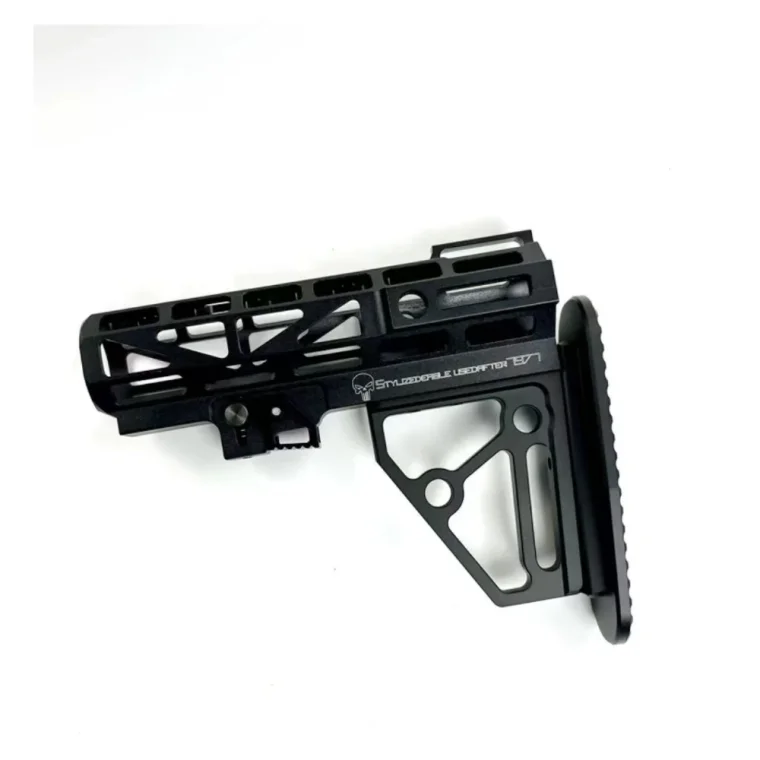Openwork (or skeletonized) gun stocks have moved from niche custom builds into mainstream firearm design. By removing material where it isn’t structurally necessary, openwork stocks reduce weight, improve ergonomics, and add distinctive aesthetics — all while maintaining strength and performance. Whether you’re a competitive shooter, a hunter, or a tactical professional, openwork stocks offer practical advantages that make them worth considering. In this article we’ll explore the top applications of openwork gun stocks in modern firearms and how specialist manufacturers like Nantong Junyuan Sports Goods Co., Ltd. contribute high-quality, innovative stock solutions for shooters and professionals alike.

1. Weight Reduction for Mobility and Endurance
One of the most immediate benefits of openwork stocks is lower weight. Removing excess material from the butt, comb, and fore-end trims ounces without compromising structural integrity.
Applications:
-
Hunting: Less fatigue on long treks and quicker target acquisition when stalking game.
-
Patrol and field operations: Easier carry for security or range personnel who need to stay mobile.
-
Sporting events: Competitors who benefit from quicker transitions and reduced bearer fatigue.
Manufacturers like Nantong Junyuan use precision molding and high-strength materials to balance weight savings with durability, ensuring the stock remains rigid where it counts.
2. Improved Recoil Management and Ergonomics
Openwork designs often incorporate geometric cutouts, reinforced ribs, and optimized contact points that refine how recoil is transmitted and distributed across the shooter’s shoulder and cheek.
Applications:
-
Tactical and duty firearms: Reduced perceived recoil helps maintain sight picture and follow-up shot accuracy.
-
Clay and target shooting: Better cheek weld and ergonomic geometry improve consistency and comfort through long sessions.
Designers can tune the layout of openwork panels and reinforcement ribs to tailor flex and energy absorption, making these stocks both comfortable and performance-oriented.
3. Enhanced Heat Dissipation and Environmental Performance
Openwork patterns increase airflow around barrels and action housings. This aids heat dissipation during rapid fire or sustained shooting sessions.
Applications:
-
High-rate-of-fire platforms: Semi-auto and support weapons that generate significant barrel heat.
-
Competition (3‑Gun, IPSC, practical rifle): Where fast strings of shots are routine and overheating can affect performance.
-
Hot or humid climates: Improved airflow reduces moisture trapping and helps keep components drier.
Well-designed openwork stocks also shed mud and debris more readily than enclosed designs, which is a practical advantage outdoors.
4. Attachment Versatility and Modular Integration
Modern openwork stocks frequently include integrated mounting points, M-LOK/KeyMod-compatible fore-ends, QD sling swivel sockets, or proprietary attachment grooves.
Applications:
-
Modular rifle platforms: Users can add bipods, lights, slings, or procedural accessories without aftermarket modifications.
-
Law enforcement and special units: Rapid customization for mission-specific loadouts.
-
Competitive shooters: Fast attachment and reconfiguration for different stages.
Nantong Junyuan and similar suppliers often offer stocks predrilled and reinforced for accessory mounting, saving time and ensuring factory-level fitment.
5. Aesthetic and Brand Differentiation
Openwork stocks make a visual statement. Consumers and OEMs use them to distinguish product lines or offer premium-looking options that signal performance orientation.
Applications:
-
Commercial firearms and upgrades: Brands offering “performance” or “sport” variants frequently pair openwork stocks with upgraded triggers and barrels.
-
Custom builds and aftermarket upgrades: Shooters seeking a distinctive look without sacrificing function.
High-end finishing options — anodizing, Cerakote-ready surfaces, or textured polymer blends — enhance both looks and durability.
6. Weight Distribution and Balance Tuning
Because material can be selectively removed, designers can shift mass fore or aft to change handling characteristics without large-scale redesigns.
Applications:
-
Precision rifles: Fine-tuning balance for bagged shooting or prone accuracy.
-
Shotguns and sporting guns: Adjusting swing dynamics for sporting clays or bird hunting.
This level of control allows OEMs and gunsmiths to offer multiple stock variants tailored for specific shooting styles.
7. Durability and Material Advantages
Contrary to the “delicate” misconception, well-designed openwork stocks use advanced polymers, reinforced composites, or metal inserts to maintain or exceed the durability of full-bodied stocks while offering the benefits above.
Applications:
-
Rugged field use: Stocks engineered to resist impact, solvents, and UV exposure.
-
Long-life commercial products: Reduced material can lower production costs while maintaining a long service life.
Nantong Junyuan’s experience in producing precision firearm components helps ensure openwork stocks meet strict quality and safety standards.
Safety, Legality, and Practical Considerations
Openwork stocks are mechanical components — always verify compatibility with your firearm’s model and local laws. Avoid any modifications that compromise safety features. When in doubt, consult the firearm manufacturer or a qualified gunsmith.
Conclusion
Openwork gun stocks offer a compelling mix of lightweight performance, improved ergonomics, heat management, and visual appeal. From hunters and competition shooters to law-enforcement professionals, these stocks serve a wide range of modern applications. Companies like Nantong Junyuan Sports Goods Co., Ltd., with a focus on high-quality gunstock manufacturing, play an important role in delivering reliable, innovative openwork solutions to the market. When selecting an openwork stock, prioritize material quality, structural design, and compatibility to get the best blend of function and form for your firearm.
www.junyuanhandguard.com
Nantong Junyuan Sports Goods Co., Ltd.
About Author
You may also like
-
What is a hexagonal bolt? Hexagonal bolt specifications
-
Shanghai Bingyin Electronics: HGuide i300 Inertial Measurement Unit endows industrial robots with a "sensitive cerebellum"
-
Understanding the Role of the Single Relay in Modern Electrical Control Systems
-
Why a Reciprocating Air Compressor Remains a Reliable Workhorse in Industrial and Commercial Applications
-
A Practical Guide to Weather Proof Sticker Materials, Performance, and Industrial Use
